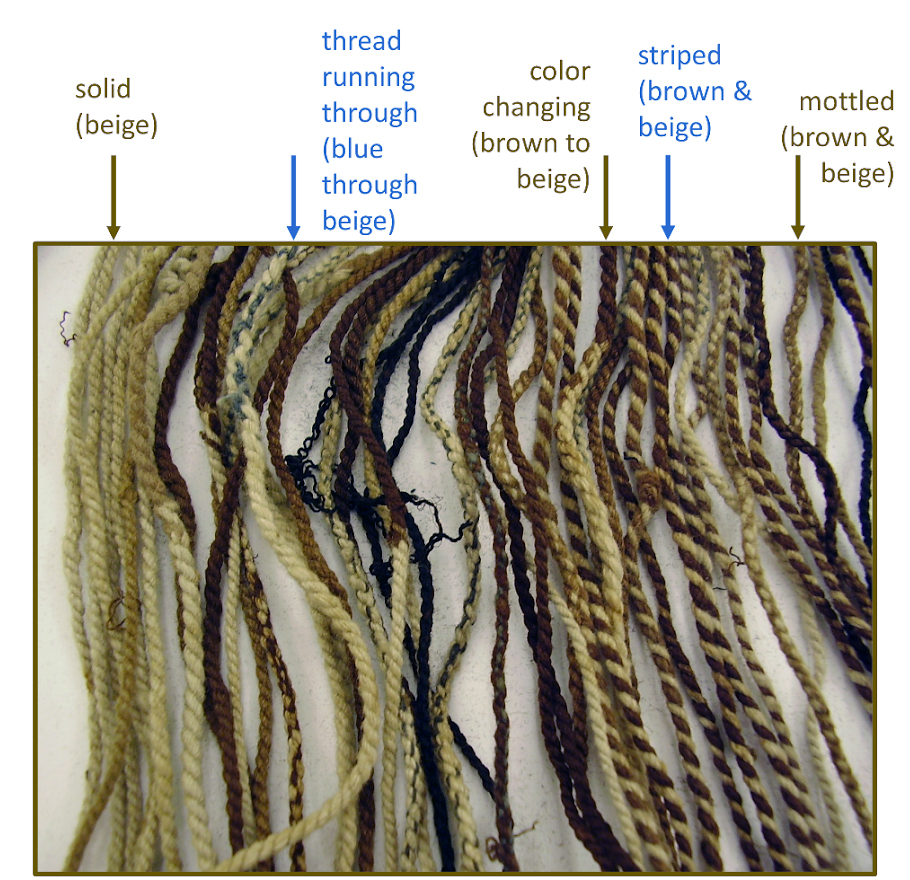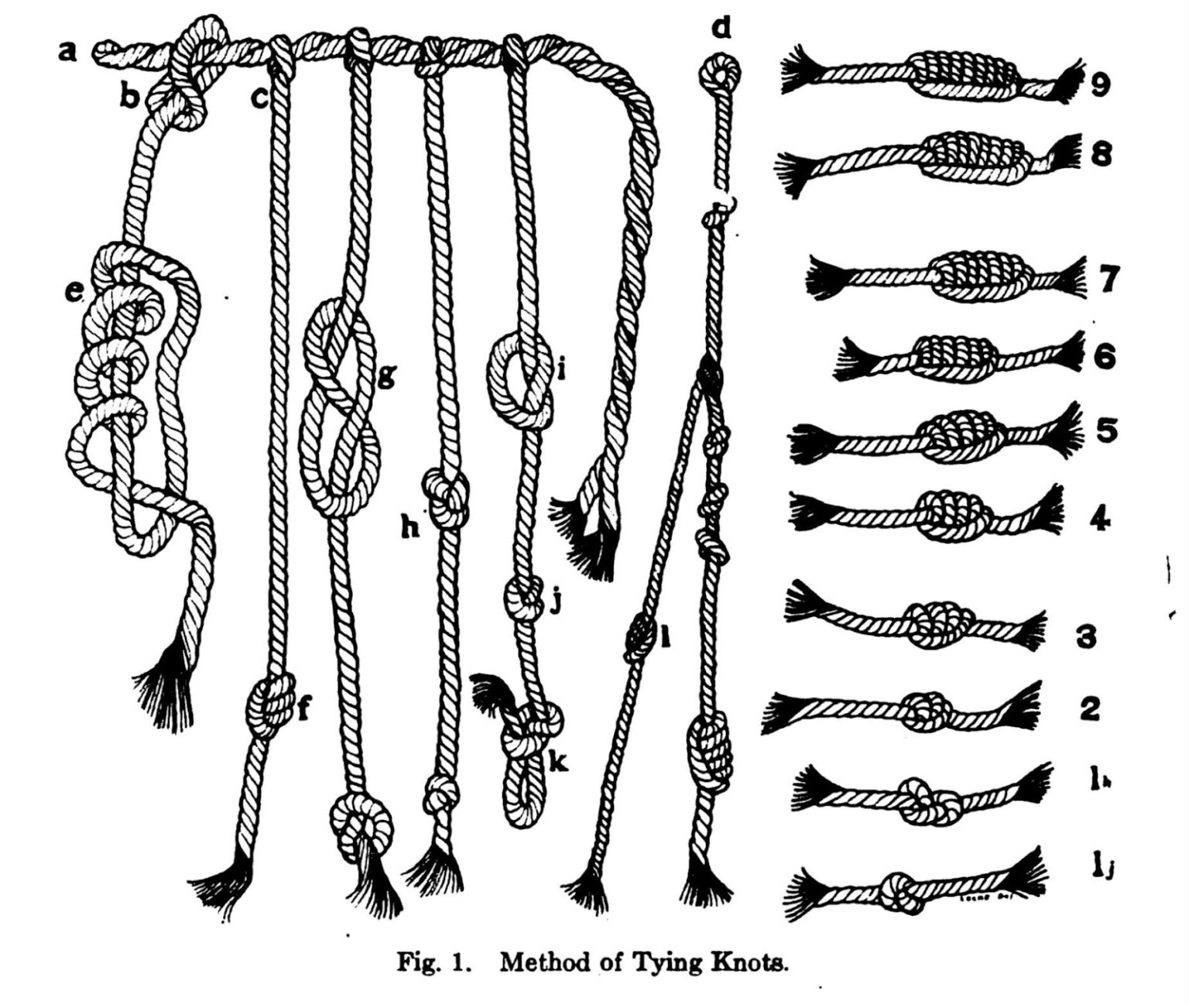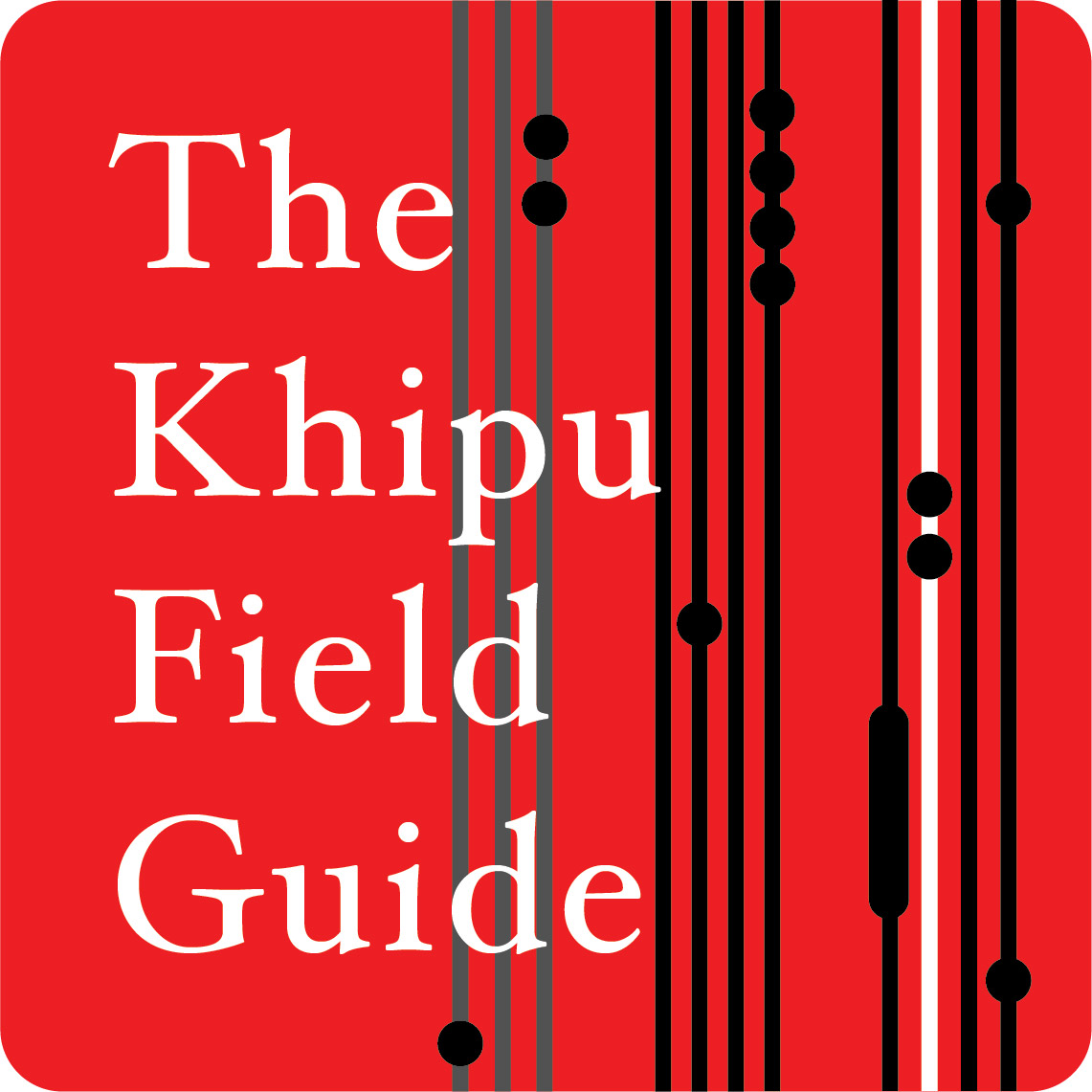Khipu Signs and Schematics
1. Gathering Signs
Khipu decipherment has largely been the successive discovery of “signs”. Like a (very bright) child identifying letters in their native script, over time we have discovered letters, and now are discovering that letters make words.
Let’s review known khipu signs, and then later in the Notebook, we’ll explore meta-level signs. As we explore khipu signs, the reader is encouraged to view the schematic below - especially the corresponding cord notes, to see how signs are visually encoded.
1.1 Demonstration Khipu Schematic
1.2 Cord Signs
The first set of signs that have been discovered over time, have to do with cords, how they are made, their color and twist, how they are attached to the primary cord, etc.
- Types
We’ve already seen in the image of the khipu above, a Primary Cord, from which are attached Pendant Cords. Pendant cords can go down (a Bottom Cord), or up (a Top Cord). Attached to pendant cords, but not to the Primary cord, are Subsidiary Cords. - Construction
Cord are generally made of one or more “strings”, that are twisted together to make a cord. Making cords is hard work, I’ve made cordage and I can tell you that this inexperienced cordage maker felt it was nothing like the romantic picture of young Inka women in a convent, peacefully spinning thread. Different types of cord fabric and color can be plied/twisted together making the following types of cords:
Examples of color combinations from a khipu. Note that these pendants are all S-plied.
Photo: Dallas Museum of Art - Dr. Kylie Quave - By permission.
- One-color - the majority of cords in the khipu field guide have only one color
- (:) Mottled cords - these cords appear mottled in color. Since two colors make up a mottled cord (ie. Black K, and White W), Marcia Ascher invented a color-naming scheme for cords. Mottled colors are represented using a colon : operator so a Black and White mottled cord would be encoded as W:K
- (-) Barberpole cords - these cords, generally of two contrasting colors plied together look like a barberpole. We haven’t deciphered barberpole meaning, yet, although I suspect they are markers of some sort. The Ascher barberpole operator is a dash -.
- (%) Striped cords - Striped longtitudinally, these cords are special unplied constructions.
- (^) Tweed cords - A khipu with these unique cords, first identified by Sabine Hyland appears in the field guide.
- (**) Dahlberg cords - These cords are unique to AS069, and AS071. AS069 is the famous 8 meter long khipu. It and its companion AS071 are missing. AS069 and AS071 are “suspect” data-entries, but they have been included for completeness.
- Twist
Additionally, and it turns out this is important, cords can be- Z twisted/plied (the braiding appears like the / diagonal in Z) or
- S-twisted/plied ( diagonal)
- Color
A standardized color scheme developed by khipu scholar Carrie Brezine has been used to annotate cord colors. Since cord colors fade over five centuries, and since one person’s light yellow brown is another person’s beige, color matching to the Brezine color chart is at best, an approximate task. I have been aided by using the Photoshop eyedropper tool to compare photographs vs the jpegs of the Brezine color chart and to remove human error due to foreground/background color misperception. While cord-colors appear to be a useful sign, I note that any advanced matching for color, has to be “fuzzy” and “approximate”. - Fiber
Sabine Hyland and her team of scholars are doing fascinating work in the fiber identification of khipu cordage. For example, the possibility that some cords might be made of human hair is a fascinating take on the cultural aspects of khipu “sacredness” and “memory”. Similar work in the dyes and textile construction reveals much information about the provenance/region of the khipu. This type of provenance information is enormously useful when evaluating “irregular” knot sequences in the field guide. Unfortunately, the database currently ignores fabric content as a search field, since the data has been so sparsely recorded. Sabine’s work will be a welcome addition to the khipu record. - Attachments
Pendant Cords can be attached to the primary cord in one of three ways - depending on how they are “looped” over the primary cord.- Verso, where the cord “choke” is visible in the front,
- Recto, where the choke is visible in the back
- Up where the pendant cord is a top cord.
- Unknown.
There is considerable data to show that the Verso/Recto attachment duality conveys significant sign information such as moiety (hanan/upper vs hurin/lower) or other binary or spatial encoding. However, since cord attachment was not acknowledged as a sign until the 1970s, many of the khipus in the KFG lack cord attachment information. Schematically, when a cord lacks attachment info, it just hangs from the primary cord with no indication of attachment.
1.3 Knot Signs

Knots e-f are long knots (values 2-9), knots g-h are figure-Eight-Knots (value 1), and knots i-j are single overhand knots (10s, 100s, etc.) Drawing of knot-tying methods from L. Leland Locke’s landmark work The Ancient Quipu or Peruvian Knot Record (1923: fig. 1, American Museum of Natural History, New York) - Courtesy of Dr. Kylie Quave - By permission.
Knots have a type (single, long, etc.), a spin (S,Z, or U for unknown), and an axial direction. The latter is a new sign that only exists for khipus recorded in the last twenty years. The KhipuFieldGuide contains the following knot-types (preceeded by their database knot code-type). The reader is encouraged to view the above schematic to see if they can identify the knot types.
- (S ) Single knots
- (L ) Long Knots
- (LL) Double Long Knots
- (B ) Belted Knots
- (SP) Spiral Knots
- (TF) Tufted Knots
- (E ) Figure-Eight-Knots
- (EE) Double Figure-Eight-Knots
- (U ) Unknown Knot Type
1.4 Cord Groups
Cords group together into sets known as “cord groups” or “cord clusters”. When cords of a similar color are grouped together, its called a banded group or banded cluster. When cords of different colors are grouped together, its called seriated. Sabine Hyland was the first to identify that banded khipus often correlated with ayllu family units and census khipus. Similarly seriated khipus were explored at length, by Carrie Brezine in her wonderfully complex and gifted study of the Purucucho Hierarchy. I have replicated that study - it reveals much about how khipus are grouped in summation hierarchies.
In Manuel Medrano’s and my study, revealed in this field guide, we discovered that the leading cord of a group often has a special significance, especially if it is white. Similarly we found that banded groups tend to average around 6 cords - believed to be an indicator of ayullu (family name) encoding. In studying cord groups, we see the first sign of “punctuation” at a larger scale. I’m the header cord. I mean something. I’m a top cord. I mean something.
In the above schematic, you will notice a light green bar across group #1. This indicates the group is seriated. Group #4, a banded group of cords all of the same color, has a light blue bar (blue for banded). The number of pendant cords, shown with the Pi π pendant symbol is listed as 4 for the Group #1. The sum of the cords Σ in Group #4 is listed as 2300. The top cord’s value (6) matches the sum of it’s left group (Σ: 6) and so it has a Σ 6 sum tagged at the attachment end of the cord.
1.5 Summation Signs
There are additional meta level signs. For example when do we have summation occuring in a khipu. We just saw our first summation sign - when top cords sum to an adjacent set of cords they become schematically marked with a Σ symbol, or a ~Σ symbol if it’s an approximate match.
Beyond this simple one-cord level, we get into the realm of “fieldmarks” and their meta level signs. In the KhipuFieldGuide Notebook Analyses, I expand the vocabulary of khipu “signs” to include “fieldmarks”, computational constructs such as statistical measures (this khipu has a LOT of high-value cords for example), relational constructs such as sums by pendant cord-group index, or by subsidiary, etc), and analytical constructs such as the amount of entropy in the khipu as a measure of its “linguistic-qualities”.

